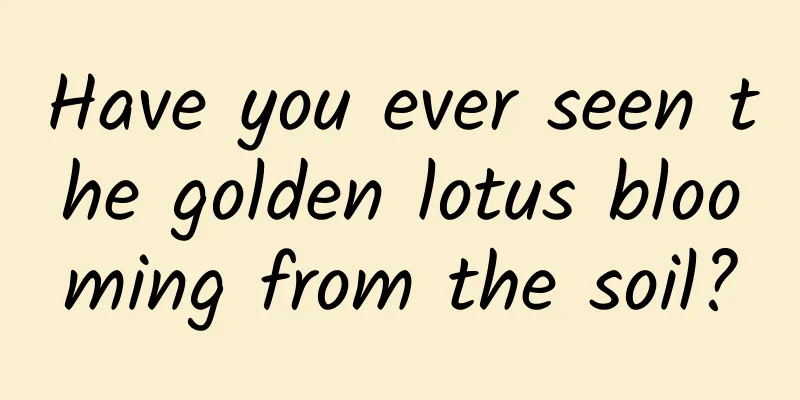Have you ever seen the golden lotus blooming from the soil?

|
The second chapter of "Journey to the West" "Awakening to the True and Wonderful Principles of Bodhi, Eliminating Demons and Returning to the Original Spirit" describes the scene when Patriarch Bodhi began to preach the Tao: "It is true: flowers are falling from the sky, and golden lotuses are surging from the ground. He expounds the Three Vehicles teachings wonderfully, and contains all the subtle dharmas. He slowly shakes his whisk to spray pearls and jade, and the sound shakes the nine heavens with thunder. He talks about Taoism for a while, and Zen for a while, and the three schools cooperate in this way. The word "enlightenment" leads to the principle of sincerity, and guides the mysterious nature of birthlessness." From then on, Wukong became enlightened, and eventually learned the somersault cloud and seventy-two transformations from the ancestor. The phrase "flowers falling from the sky and golden lotuses gushing from the ground" to describe Bodhi Patriarch's teachings is not just a random creation of the author. Legend has it that this wonderful scene will occur when a great Buddhist master gives a wonderful lecture. The "flowers from the sky" comes from the Lotus Sutra, a Buddhist scripture, and refers to the four types of flowers: Mandragora, Mahamandragora, Manjushaka, and Mahamanjushaka. The "golden lotus" generally refers to our protagonist today - the golden lotus (Musella lasiocarpa). Part 1 The sacred flower of Buddhism, a rare flower in central Yunnan Musella lasiocarpa (scientific name: Musella lasiocarpa), commonly known as thousand-petal lotus and ground nasturtium, is the only species of the genus Musella in the Musaceae family. It is a perennial herb native to central to western Yunnan Province, China, and is also one of the representative species of dry and hot valley landforms. The above-ground part of the ground nasturtium is similar to the banana tree we are more familiar with, with broad and thick leaves, and the base of the leaves is tightly packed together to form a thick pseudostem. Its eye-catching large golden "flowers" are actually inflorescences composed of many small flowers and bracts. The inflorescence grows out from the middle of the pseudostem, and large yellow bracts shaped like petals unfold layer by layer from the bottom of the inflorescence. The small flowers wrapped in these bracts are the real flowers. Similar to banana flowers, the small flowers of the ground nasturtium are also divided into female flowers and male flowers, growing respectively at the bottom and top of the inflorescence. Figure 1. Beautiful ground lotus (Photo credit: flickr/ Linda De Volder) Figure 2. Small flowers in the inflorescence of the ground nasturtium (red box) (Image source: flickr) The above-ground pseudostem of the ground lotus is relatively short, less than 60 cm in height. In addition, it often blooms before leaves, giving people the feeling that it suddenly emerges from the ground and blooms into a golden lotus, which is why it got its name. The ground lotus not only has beautiful flowers, but also has a flowering period of about 250 days. In the south, if it is properly maintained, it can be appreciated almost all year round. Therefore, it is cultivated as an excellent ornamental flower. There are now multiple cultivars with different plant shapes and flower colors. At the 5th China Potted Flower Trade Fair, five flower species including the ground lotus stood out from more than 1,000 selected works and won the Golden Flower Award. Figure 3. A new variety of ground lotus, “Foyue Jinlian”. This variety was bred from a natural variant of the wild ground lotus population through single plant asexual reproduction. (Image source: References) The bracts of the ground lotus are like the petals of lotus, overlapping and staggered, with dazzling golden color and always blooming, just like the thousand-petal lotus most respected in Buddhism. In addition, there is a legend that "flowers fell from the sky and golden lotus sprang from the ground" where the Buddha preached. The ground lotus is often revered as a sacred flower of Buddhism. In Theravada Buddhism, the ground lotus is designated as one of the "five trees and six flowers" that must be planted in temples. Ethnic minorities such as the Dai people worship Buddhism. Many tourists who have traveled to places where Buddhism flourishes, such as Xishuangbanna, can find traces of it in front of and behind Buddhist temples and Dai people's houses. This shows the respected status of the ground lotus in Buddhism. Part 2 It is both delicious and good medicine The ground-blooming golden lotus not only has extremely high ornamental value and religious and cultural value, but also has certain edible value. Central Yunnan is a region where ground lotus is commonly grown. Ethnic minorities such as the Yi and Naxi people here use ground lotus to make delicious dishes to entertain guests. The young inflorescence and the center of the pseudostem of ground lotus are edible parts, but they need to be blanched and soaked before eating to remove the bitter taste. They can then be used for cold dishes, or cut into strips and stir-fried with meat or cooked in soup. The pseudostem of ground lotus has a starch content of more than 50%. In the era of food shortage, locals would slice it and dry it as food storage. It is said that in a few areas, these starch-rich parts are also used as raw materials for brewing. In fact, being served on people's tables is not the most important practical value of ground nasturtium. It has another main use in the local area, which is to feed pigs. Research surveys show that the protein content in the leaves and inflorescences of ground nasturtium is extremely high, reaching 17.25% and 11.42%. In contrast, the protein content of corn, which is often used as feed, is only about 4%. Therefore, ground nasturtium is a very high-quality forage plant. In central, northern and northeastern Yunnan, local Yi people plant ground nasturtium in front of and behind their houses and use the whole plant as pig feed. They found that livestock fed with ground nasturtium grow faster and have more delicious meat. Figure 4. Nutrient content of various parts of the ground lotus (Image source: References) Modern analysis has found that the ground lotus is rich in a variety of fatty acids and esters, terpenes, and flavonoids, and has a wide range of anti-inflammatory and antioxidant drug development potential. Part 3 Protection is urgent Although the ground orchid is widely cultivated and planted because of its multiple values, people often ignore the survival status of its wild populations because of this. The ground nasturtium is native to the river valley rock walls at an altitude of 1500-2500 meters in Sichuan and central to western Yunnan. Because its native habitat is very special and highly fragmented, it is difficult for ordinary people to see its wild population. Wild ground nasturtium can reproduce asexually or sexually through seed production, but researchers have observed that its seed germination rate is abnormally slow (probably due to genetic degeneration caused by inbred breeding). A study analyzed the genetic structure of 24 individuals from three wild populations and found that the heterozygosity of genetic markers of wild ground nasturtium was significantly low. This shows that the wild population of ground nasturtium has low genetic diversity and weak ability to resist environmental changes. The ecosystem in which the wild ground nasturtium is located is very fragile, with serious soil erosion. In recent years, the trend of desertification and vegetation degradation has intensified. Coupled with years of human excavation, its survival situation is not optimistic. Figure 5. Wild ground lily (in the dotted box) and its habitat (Image source: References) Figure 6. Wild Musella lasiocarpa var. rubribracteata and its habitat (Image source: References) In short, as we strengthen the construction of ecological civilization, we should pay more attention to the protection of wild germplasm resources of rare plants such as ground lily. We can actively ban the collection and strengthen the publicity of plant protection in the local area, standardize the process of using wild ground lily for scientific research, breeding and gardening, and expand its wild population through reintroduction. I hope this beautiful and holy lotus can continue to bloom on the rock wall. References: 1. Zhou Yilan & Long Chunlin. (2019). Golden Lotus nurtured by traditional ethnic culture. Science (02), 17-19. 2. Li Xiaojiang. (2001). Research on the development and utilization of ground lotus resources and sustainable development. Journal of Xichang University (Natural Science Edition) (03), 3-5. 3. Ma Hong, Li Zhenghong, Wan Youming & Liu Xiuxian. (2013). A new cultivar of ground lotus, 'Foyue Jinlian'. Acta Horticulturae Sinica (06), 1219-1220. doi:10.16420/j.issn.0513-353x.2013.06.029. 4. Long, C., Ahmed, S., Wang, 5. Liu, AZ, Kress, WJ, & Long, CL (2003). The ethnobotany of Musella lasiocarpa (Musaceae), an endemic plant of southwest China. Economic botany, 57(2), 279-281. 6. Li, R., Ru, Y., Wang, Z., He, X., Kong, KW, Zheng, T., & Zhang, X. (2021). Phytochemical composition, antioxidant activity, and enzyme inhibitory activities (α-glucosidase, xanthine oxidase, and acetylcholinesterase) of Musella lasiocarpa. Molecules, 26(15), 4472. 7. Hong, M., Qingjie, P., Lan, W., Zhenghong, L., Youming, W., & Xiuxian, L. (2011). Musella lasiocarpa var. rubribracteata (Musaceae), a new variety from Sichuan, China. Novon: A Journal for Botanical Nomenclature, 21(3), 349-353. Produced by: Science Popularization China Author: CPY (School of Life Sciences, Peking University) Producer: China Science Expo The article only represents the author's views and does not represent the position of China Science Expo This article was first published in China Science Expo (kepubolan) Please indicate the source of the public account when reprinting Please indicate the source of the reprint. Reprinting without authorization is prohibited. For reprint authorization, cooperation, and submission matters, please contact [email protected] |
<<: Ocean energy research: understanding the ocean's climate code
>>: The undercurrent of climate change is hidden in this wave of atmosphere
Recommend
Is the story of “The Crow and the Pitcher” true?
Is the story of “The Crow and the Pitcher” true? ...
Understanding iOS memory management
Stories from ancient times Those who have experie...
A holy place for stargazing in the dark night: How “hardcore” is Mount Lemmon Observatory?
Author: Du Lian Audit│Ding Yi Editor: Zhao Jingyu...
Taro cross-terminal solution for Ctrip’s mini-program ecosystem
Author|Ctrip's front-end framework team prov...
Online education will face dramatic changes; Hujiang appeared at GMIC to start a new wave of AI teaching
When it comes to artificial intelligence, most pe...
Live streaming craze is fading, and losses of online celebrity e-commerce may become the norm
When it comes to Hangzhou Ruhan Holding Co., Ltd....
J-20, Y-20, Z-20, why are the most powerful aircraft all called 20? | Great Power Technology Fan
China's "Sky Eye", Shenzhou spacecr...
What's the difference of 2,000 yuan? A comprehensive comparison between iPhone SE and iPhone 6S
The iPhone SE was released again with all the spo...
Are the materials submitted for information flow advertising repeatedly rejected? You haven't learned this internal audit rule yet!
With the 19th National Congress of the Communist ...
[Live] Wang Jian, Technical Director of iFlytek Open Platform: How to create a natural human-computer interaction experience
[51CTO.com original article] Since the birth of c...
Why does Jack Ma, who is so awesome, still need a TV station during Singles’ Day?
1. The show begins On the evening of November 10,...
Do you dare to challenge a cup of cockroach milk?
Key Points ★ "Cockroach milk" is not or...
A complete marketing planning template!
The complete market plan is mainly divided into t...
Homemade wine tastes great, naturally pure? But I urge you to be careful...
It is the grape harvest season again. Many people...
Sony SRF-V1BT Bluetooth Speaker FM/AM Radio Review
Not long ago, Sony (China) Co., Ltd. officially r...









